
The trip to Kilimanjaro and Tanzania ended but the memories will remain etched in my mind forever. PHOTOS: IMAD BROHI
Beauty at its ‘peak’: Climbing the majestic Mount Kilimanjaro, the roof of Africa
One of the 7 summits and the tallest free-standing mountain in the world. Oh and it's visa on-arrival for Pakistanis!
At 5,895 metres, Mount Kilimanjaro is the highest peak in the continent of Africa. Though dormant now, it is also the highest volcano in the world outside of South America. The mountain is one of the seven summits (a term used for highest peak in each of the seven continents). From the plains of Moshi to its summit, the mountain rises a staggering 5,100 metres, which makes it the tallest free-standing mountain on the planet. While it may not be for the faint-hearted, for many trekking/mountain climbing enthusiasts like myself, it is one of the starting points of their climbing career.
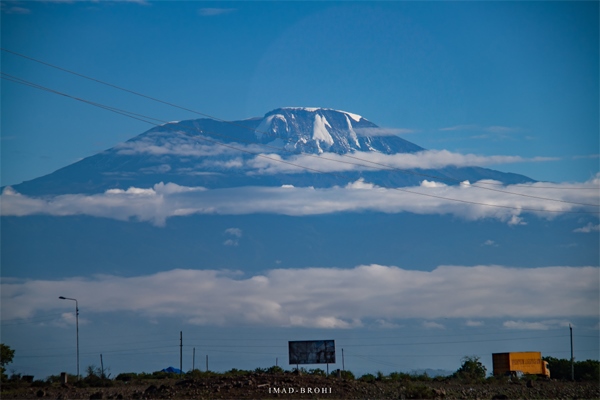 At 5895 metres, Mount Kilimanjaro is the highest mountain in the continent of Africa and one of the seven summits.
At 5895 metres, Mount Kilimanjaro is the highest mountain in the continent of Africa and one of the seven summits.Tanzania: Home of Kilimanjaro
The mountain is located in North Tanzania, close to its border with Kenya and near the towns of Moshi and Arusha. The closest airports are Arusha Airport and Kilimanjaro International Airport. Visa is on-arrival for Pakistani passport holders which is a great convenience.
Ascent routes
There are several ascent routes on Kilimanjaro, all non-technical climbs. Some of these routes and their descriptions are given below:
1. Marangu: Relatively easier, accommodation in huts
2. Rongai: Easiest route, excellent success rate
3. Machame: Most popular, most scenic
4. Lemosho: More scenic, expensive
5. Shira: Similar to Machame, but tough first day
6. Umbwe: Very direct, very steep. Exposed in parts
7. Northern: New route. Longer, easier
We ascended the mountain by the popular Machame route. Though more difficult than the Marangu route, it is more scenic and passes through different habitats ranging from rain forest to semi desert and alpine desert.
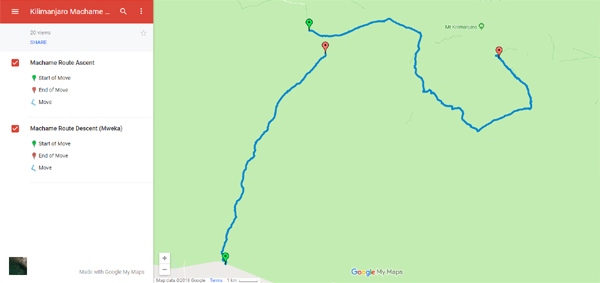
Preparation and gear
Preparation for Kilimanjaro (or any such expedition) is the key to climbing success. Most of the expeditions allow around 20 kilograms of personal items that are carried by the porters. Here is a list of my personal items at Kilimanjaro.
1. Clothing: Hard shell jacket/pants, rain jacket/pants, hiking shirts/pants, base layer, fleece jacket, thin gloves, heavier gloves for summit day, sturdy hiking boots.
2. Gear: A 52-litre backpack to carry daily personal items, zero-degree Fahrenheit sleeping bag, headlamp, batteries, camera, tripod, water bag or bottles.
3. Food: Expedition company should provide three meals a day but you may carry your energy bars and so on.
To climb Kilimanjaro, one must sign up with an expedition company. The expedition company will take care of all the permits and clearances. I joined a company called Climb Kili just based on an acquaintance's experience. I met our climbing guide Herment Mosha at the airport and later in the hotel, met three other trekkers who I was going to be climbing with.
Machame Gate to Machame Camp
The first day starts on a wide trail through a dense forest, green and refreshing. There were no scenic views on this day but the flora and fauna that kept the trek interesting. We saw white neck raven, blue monkey, fireball lily flowers and other interesting plants along the way. The trail soon got thinner but still remained a standard trek all the way to the Machame camp. As we approached the camp, the ascent became flat and the valley opened up.
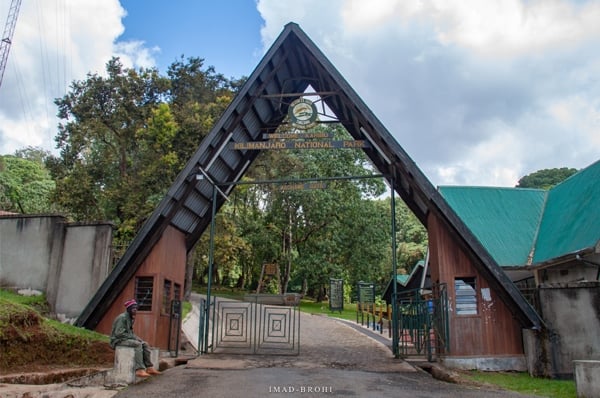 Machame Gate, the starting point of Machame route.
Machame Gate, the starting point of Machame route.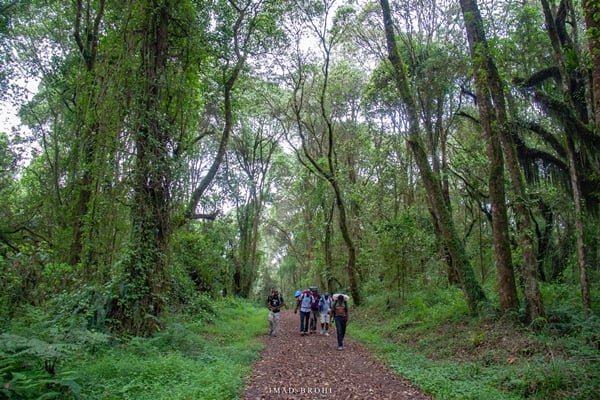 Day 1: The trail starts wide in a thick green rainforest. This part of the mountain can see a lot of rain and can get slippery.
Day 1: The trail starts wide in a thick green rainforest. This part of the mountain can see a lot of rain and can get slippery.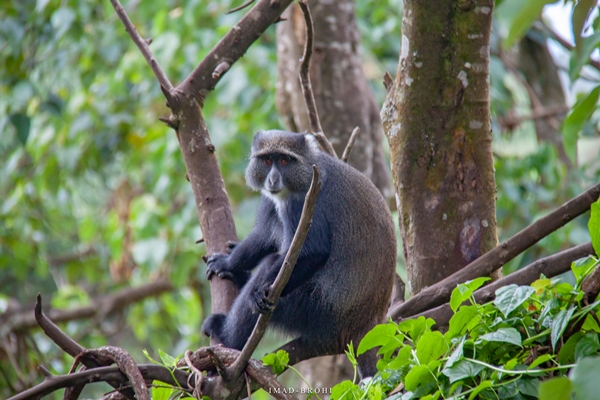 Day 1: A blue monkey on the trail.
Day 1: A blue monkey on the trail.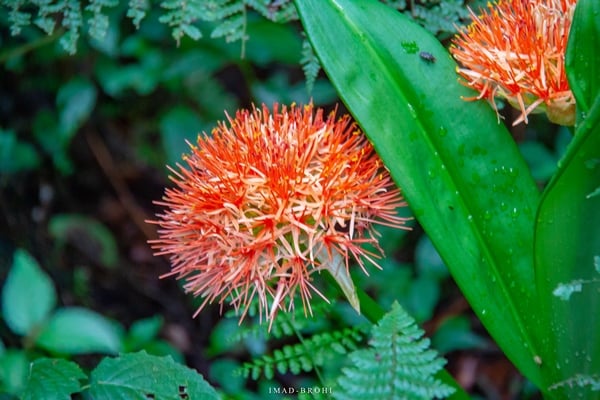 Day 1: A fireball lily flower.
Day 1: A fireball lily flower.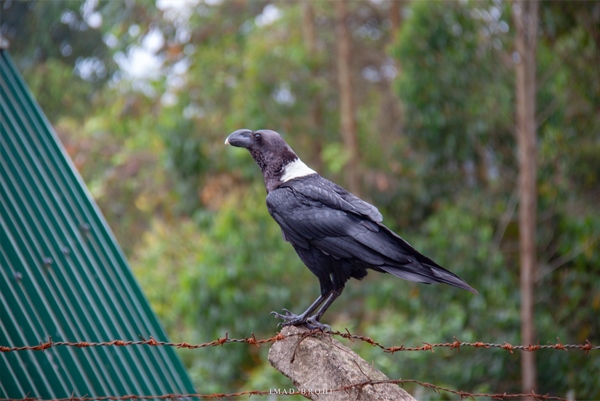 Day 1: A White Necked Raven.
Day 1: A White Necked Raven.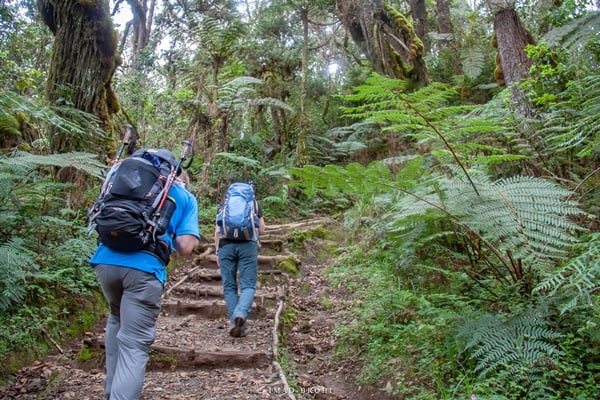 Day 1: The trail then thins out and gets steeper.
Day 1: The trail then thins out and gets steeper.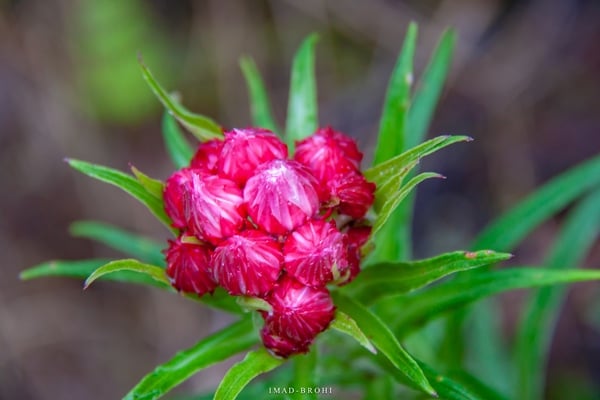 Day 1: A fresh helichrysum meheri-johanis flower.
Day 1: A fresh helichrysum meheri-johanis flower.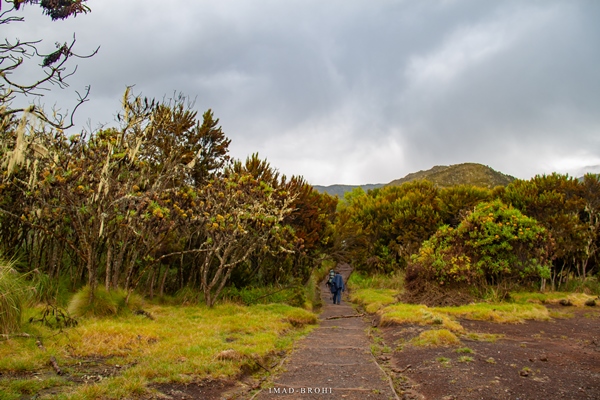 Day 1: The views open up as we approach the camp.
Day 1: The views open up as we approach the camp.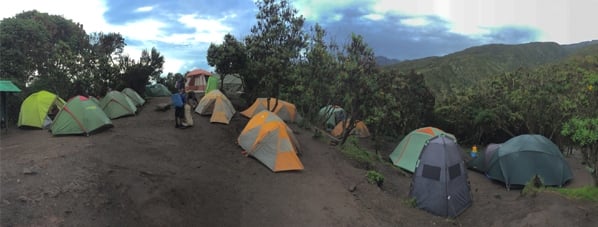 Day 1: Machame Hut Camp.
Day 1: Machame Hut Camp.Machame Camp to Shira Hut
After Machame Camp, the trek starts on a thin trail, mostly through grass with steep ascent. After an hour of climb, the valley opens up and then a simple trek takes us all the way to Shira campsite (3,810 metres). It is here where many people start feeling the effects of altitude sickness. The campsite is named after one of the three cones of Kilimanjaro: Shira, Kibu and Mawenzi. Shira peak, however, has sunk in over geologic times. The campsite offers a beautiful view of Mount Meru and the town of Moshi.
 Day 2: Next morning the group prepares to climb.
Day 2: Next morning the group prepares to climb.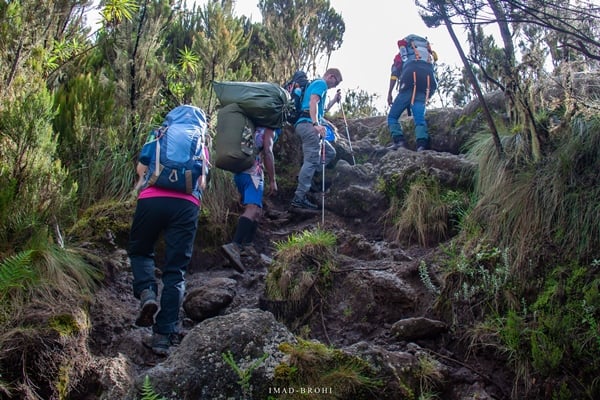
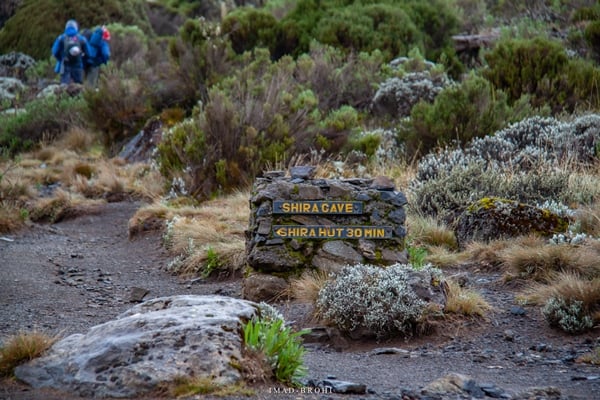 Day 2: At Shira campsite.
Day 2: At Shira campsite.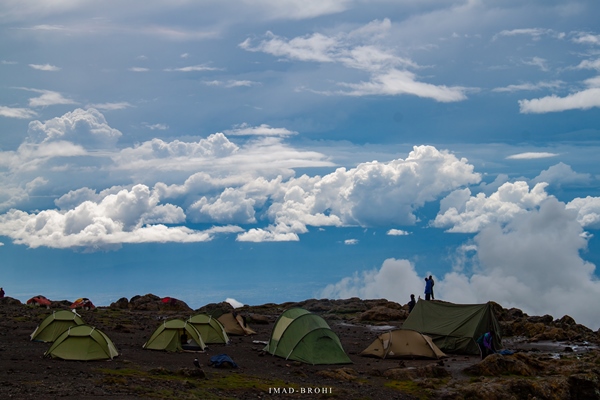 Day 2: Shira Camp in the clouds at an elevation of 3810 metres.
Day 2: Shira Camp in the clouds at an elevation of 3810 metres.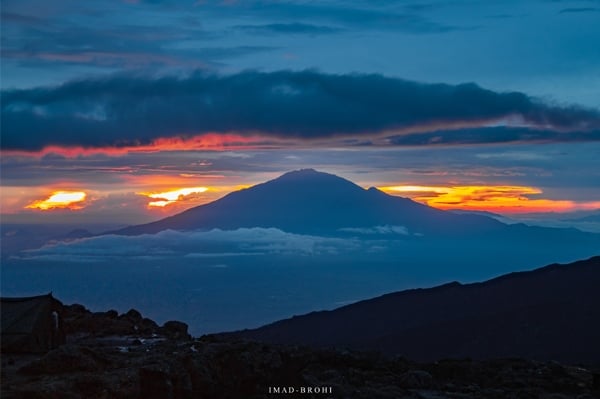 Day 2: Sun sets behind and clouds halo over Mount Meru, Tanzania’s second and Africa’s third highest mountain.
Day 2: Sun sets behind and clouds halo over Mount Meru, Tanzania’s second and Africa’s third highest mountain.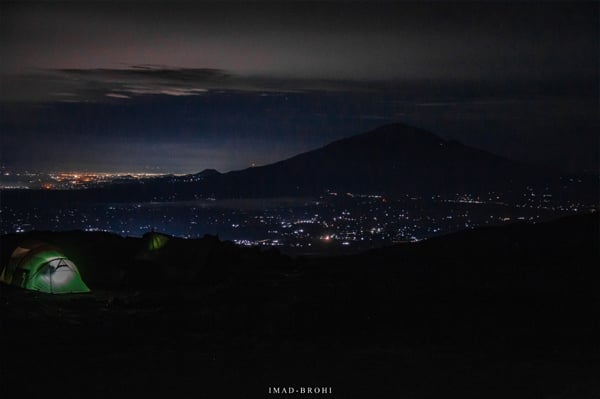 Day 2: Town of Moshi lit up after sunset.
Day 2: Town of Moshi lit up after sunset.Shira Camp to Barranco Camp
The third day is very important for acclimatisation as the route climbs high to Lava Tower (4,600 metres) where parties have lunch and then descend to Barranco Campsite (3,960 metres); an acclimatisation technique called climb high, sleep low. It was a very beautiful day with an exceptional view of the volcanic valley. It is also where we saw Drendosenecio Kilimanjari, a plant native only to the slopes of Kilimanjaro, for the first time. We also saw Lobelia Deckeni, a plant that is only found in the mountains of East Africa between 3,800 and 4,300 metres. Approaching the camp, the view became more beautiful with tens, maybe hundreds of Drendosenecio Kilimanjari along the way until we noticed a camp sitting under a massive rock wall.
 Day 3: The barren, rocky terrain onwards from Shira
Day 3: The barren, rocky terrain onwards from Shira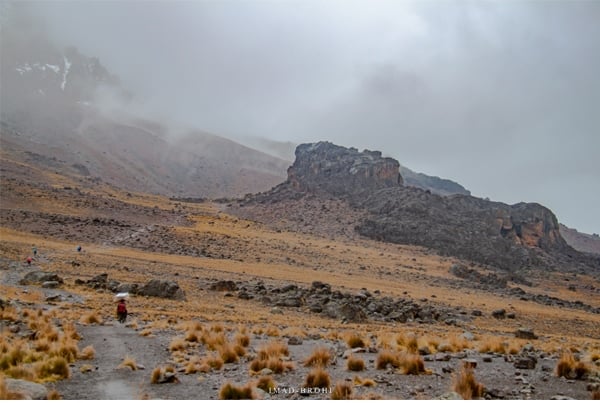 Day 3: Approach to Lava Tower. Lava Tower is a volcanic plug left over from times when Kilimanjaro was an active volcano. This was our lunch stop and an acclimatisation opportunity.
Day 3: Approach to Lava Tower. Lava Tower is a volcanic plug left over from times when Kilimanjaro was an active volcano. This was our lunch stop and an acclimatisation opportunity.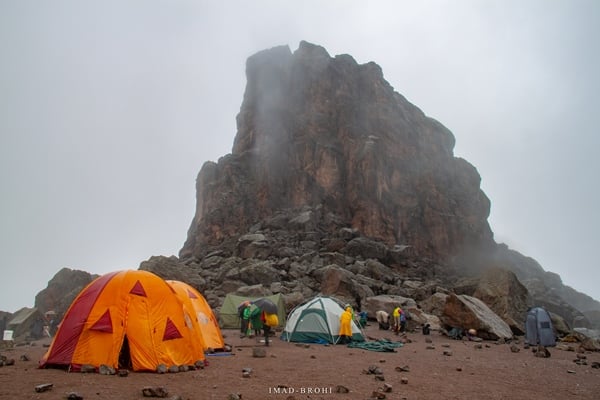 Day 3: Teams having lunch at Lava Tower, approximately 4600 metres.
Day 3: Teams having lunch at Lava Tower, approximately 4600 metres. Day 3: Trekking in the semi-desert, towards Barranco Camp.
Day 3: Trekking in the semi-desert, towards Barranco Camp.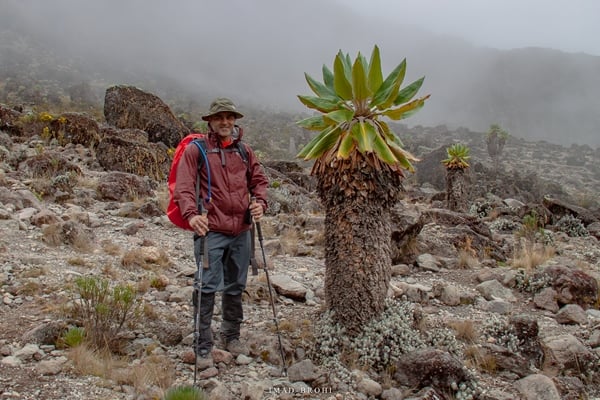 Day 3: With Dendrosenecio Kilimanjari, a giant groundsel native only to slopes of Kilimanjaro.
Day 3: With Dendrosenecio Kilimanjari, a giant groundsel native only to slopes of Kilimanjaro. Day 3: A Lobelia Deckeni.
Day 3: A Lobelia Deckeni.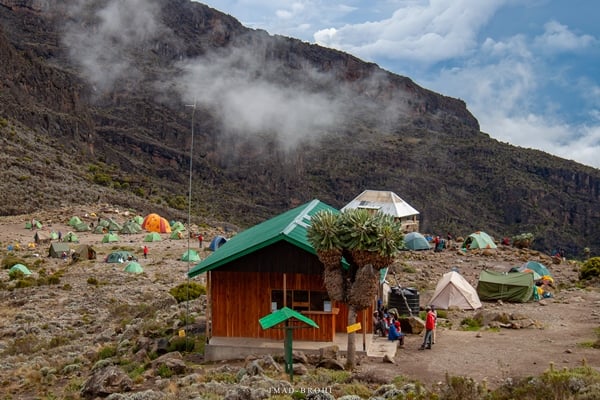 Day 3: First views of the Barranco camp at 3,960 metres.
Day 3: First views of the Barranco camp at 3,960 metres.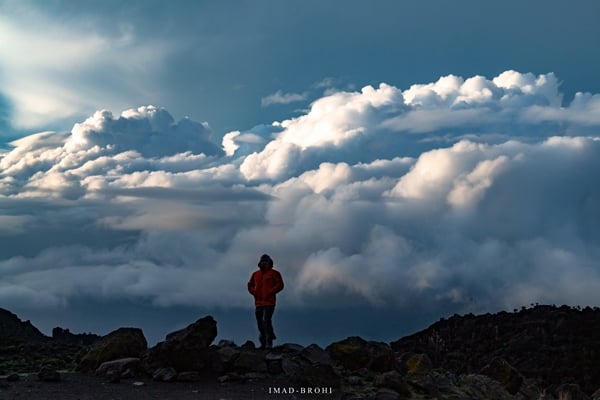 Day 3: Among the clouds at Barranco.
Day 3: Among the clouds at Barranco.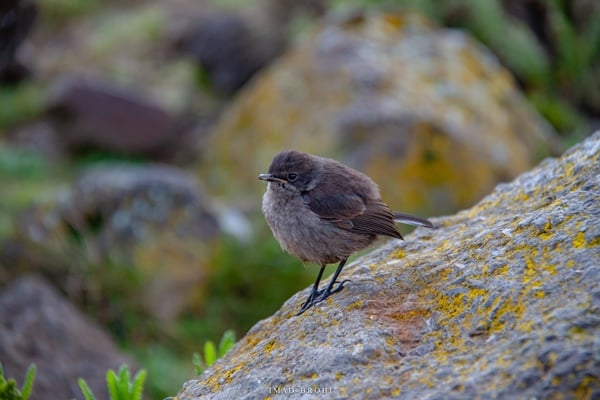 Day 3: Alpine chat at Barranco.
Day 3: Alpine chat at Barranco. Day 3: Our camp by the Great Barranco wall, our objective for the first 90 minutes of fourth day. Also called Breakfast wall, as climbers have breakfast just by this great slab of rock.
Day 3: Our camp by the Great Barranco wall, our objective for the first 90 minutes of fourth day. Also called Breakfast wall, as climbers have breakfast just by this great slab of rock.Baranco Camp to Karanga Camp
Day four is the most exciting of this trek as we challenge the massive Barranco wall. The wall did look intimidating from the camp but it turned out to be much more fun than scary. There are a few spots with some exposure particularly one called ‘the hug and kiss rock’. Once at the top of the wall, it is a simple hike to the Karanga camp. It was at Karanga where we get the first views of Kibo, the highest peak of Kilimanjaro and our ultimate target.
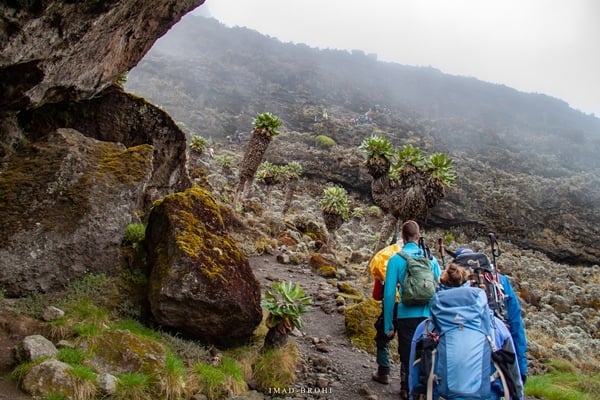 Day 4: We begin our approach towards the wall.
Day 4: We begin our approach towards the wall.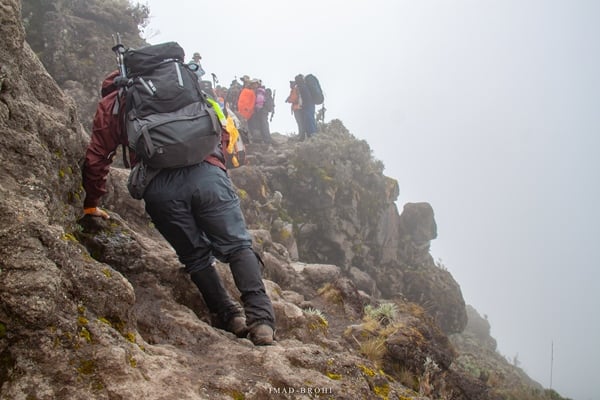 Day 4: I did not know I was being shot here. The fog was making it very slippery and to the right was a near vertical drop. I just used my hands to stick to the wall.
Day 4: I did not know I was being shot here. The fog was making it very slippery and to the right was a near vertical drop. I just used my hands to stick to the wall.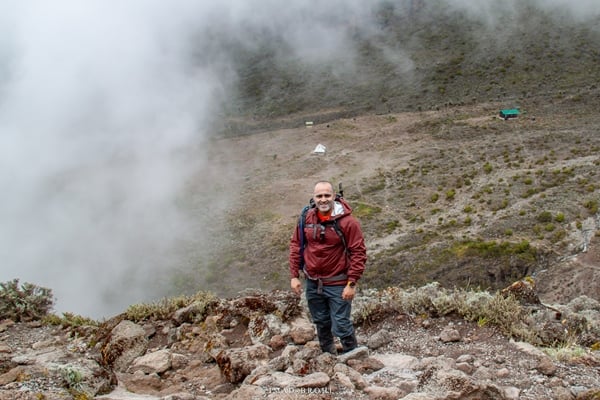 Day 4: I am all smiles after conquering most of the Barranco Wall.
Day 4: I am all smiles after conquering most of the Barranco Wall. Day 5: A foggy evening at Karranga. The main summit of Kilimanjaro, Kibo peak, in the background.
Day 5: A foggy evening at Karranga. The main summit of Kilimanjaro, Kibo peak, in the background.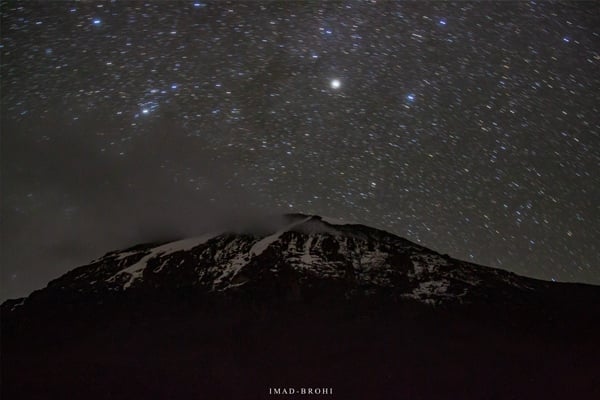 Day 5: The stars over Kibo Peak was a fascinating view.
Day 5: The stars over Kibo Peak was a fascinating view.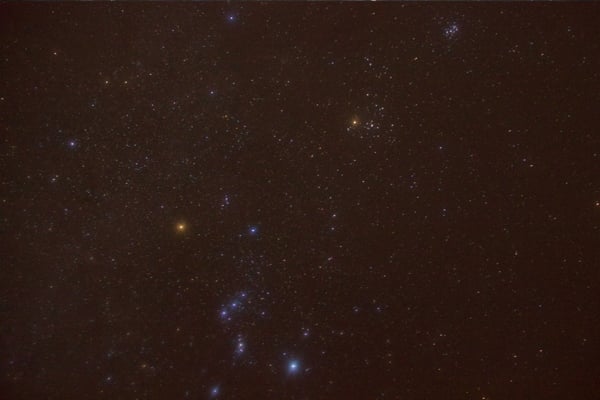 Day 4: The constellations of Orion, Taurus and Pleiades brighten up the night sky over Kilimanjaro.
Day 4: The constellations of Orion, Taurus and Pleiades brighten up the night sky over Kilimanjaro.Karanga to Barafu
Karanga to Barafu is a short day trip and some parties combine it with day four. But having it shorter is better in my opinion, as it gives some time to rest before the summit push. It starts simple with a stroll across the barren valley but there is a steep climb just before the Barafu camp at 4,665 metres.
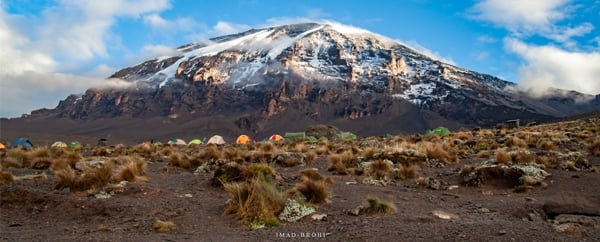 Day 5: Morning view of Kibo peak from Karranga camp.
Day 5: Morning view of Kibo peak from Karranga camp.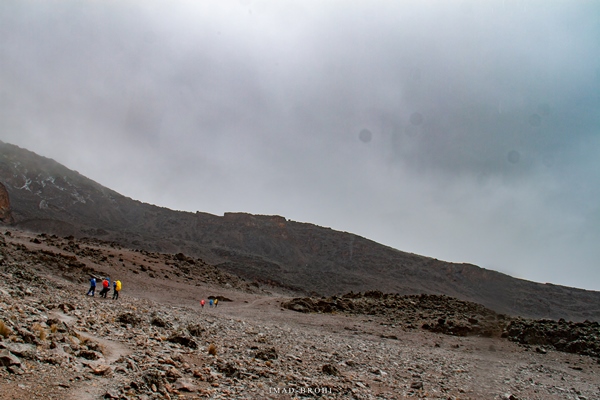 Day 5: Trekking through the alpine desert environment to Barafu Camp.
Day 5: Trekking through the alpine desert environment to Barafu Camp.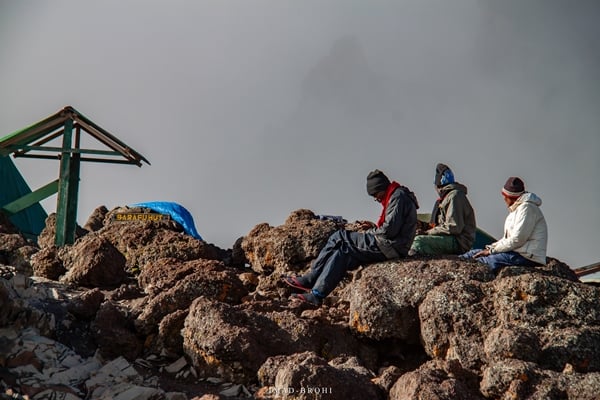 Day 5: Arriving at Barafu campsite at 4660 metres early in the afternoon.
Day 5: Arriving at Barafu campsite at 4660 metres early in the afternoon. Day 5: The evening before our summit push, the Mawenzi peak got out of the clouds to reveal itself. Mawenzi peak is 4550 metres and along with Kibo, one of the two remaining peaks of Kilimanjaro.
Day 5: The evening before our summit push, the Mawenzi peak got out of the clouds to reveal itself. Mawenzi peak is 4550 metres and along with Kibo, one of the two remaining peaks of Kilimanjaro.The summit push
After reaching Barafu, we were served an early lunch and went into our camps to sleep before the summit push. It was very quiet and slowly tents lit up as climbers got ready to prep for the summit. After a few minutes, we could see a long line of hikers heading up, their head lamps lit up in the darkness on the mountain. This was probably the toughest night for most of us. Lower oxygen levels and steep ascent makes the climb extremely difficult.
 Day 5: A long exposure of the Kibo peak with star trails in the back just before the fog set in.
Day 5: A long exposure of the Kibo peak with star trails in the back just before the fog set in.After five to six hours of gruesome trekking, we finally reached Stella Point, the rim of the volcanic crater (5,756 metres). From here we witnessed an incredible sunrise, one that we will never forget. From Stella Point to summit is a 45-minute gentle push at the crater rim, but the fatigue makes it difficult at this point.
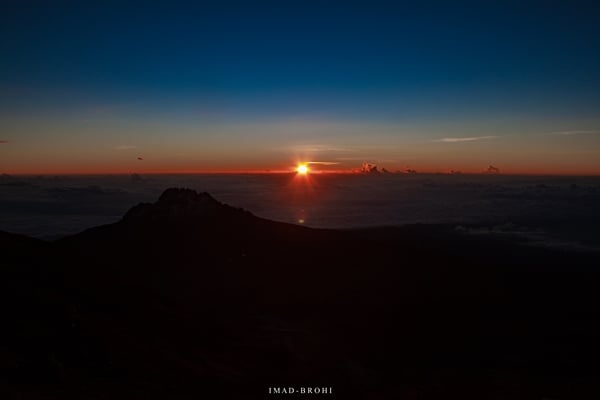 Day 6: Sunrise from Stella Point (5756 metres).
Day 6: Sunrise from Stella Point (5756 metres).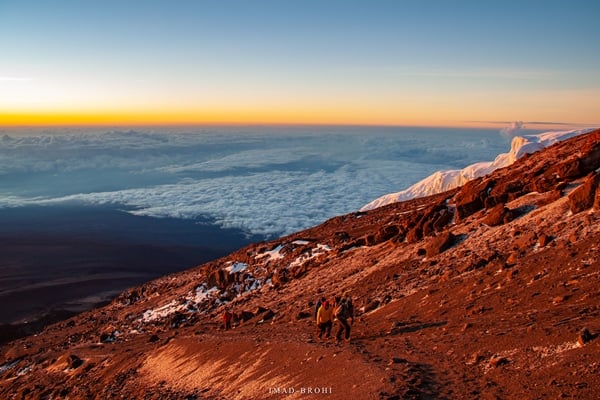 Day 6: Trekkers following towards Stella Point after sunrise.
Day 6: Trekkers following towards Stella Point after sunrise.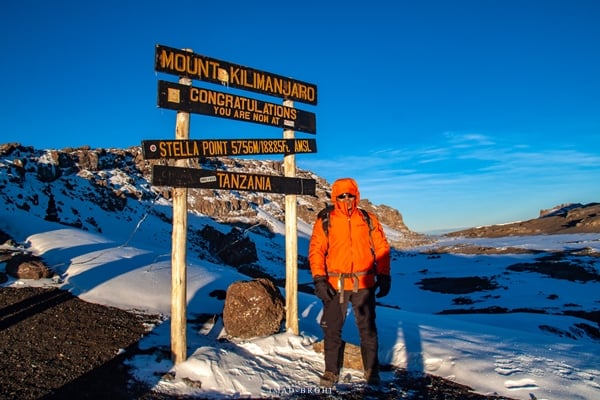 Day 6: Stella Point, crater rim, at 5756 metres.
Day 6: Stella Point, crater rim, at 5756 metres.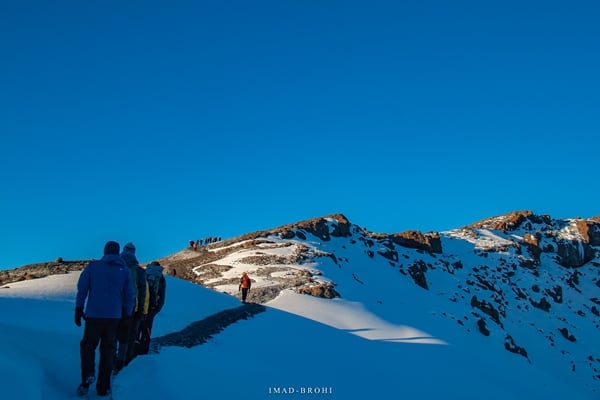 Day 6: From Stella Point, the hardest point of the climb is over. Now is a gradual walk to the summit on the crater rim.
Day 6: From Stella Point, the hardest point of the climb is over. Now is a gradual walk to the summit on the crater rim. Day 6: The Rebmann Glacier near the summit of Kilimanjaro.
Day 6: The Rebmann Glacier near the summit of Kilimanjaro.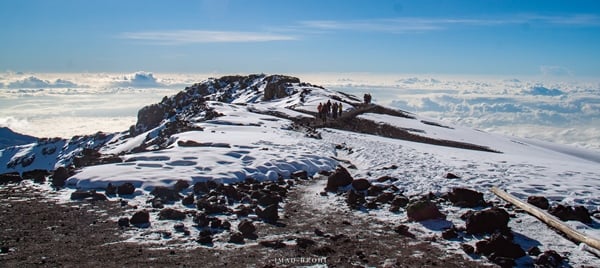 Day 6: Looking back at the route from the summit. Trekkers arriving from Stella Point.
Day 6: Looking back at the route from the summit. Trekkers arriving from Stella Point.Descent to Barafu and Mweka Camps
We stayed at the summit for a few minutes, taking pictures before starting our descent. In the next few hours, we had returned at Barafu campsite. After lunch and a quick nap, we descended another 10 kilometres down to Mweka Camp.
 Day 6: The top of Mawenzi peak amid the clouds.
Day 6: The top of Mawenzi peak amid the clouds. Day 6: Mawenzi Peak.
Day 6: Mawenzi Peak.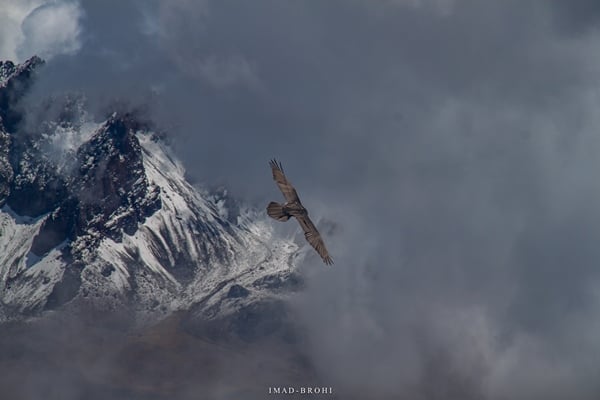 Day 6: A Lammergeyer (or a bearded vulture) flies with Mawenzi Peak in the background
Day 6: A Lammergeyer (or a bearded vulture) flies with Mawenzi Peak in the backgroundMweka Camp to Mweka Gate
From Mweka camp to Mweka gate, where the hike ends, is a 10 kilometres hike through the rain forest much like day one but with lots of flora and fauna.
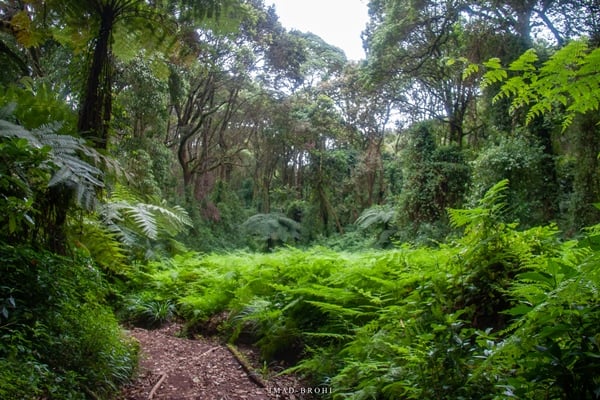 Day 7: The fresh rainforest of Kilimanjaro.
Day 7: The fresh rainforest of Kilimanjaro. Day 7: Impatiens Kilimanjari, these sea horse look alike flowers grow around an inch long and look beautiful.
Day 7: Impatiens Kilimanjari, these sea horse look alike flowers grow around an inch long and look beautiful.At the gate was a national park outpost where we received our certificates for a successful ascent of Kilimanjaro. The organisers had arranged a small lunch there with some live music which was fantastic to end a tough climb. We ended the trip with some songs and dance, singing the famous Kilimanjaro song and later drove back to Arusha to take our flights back home.
The trip to Kilimanjaro and Tanzania ended but the memories will remain etched in my mind forever.
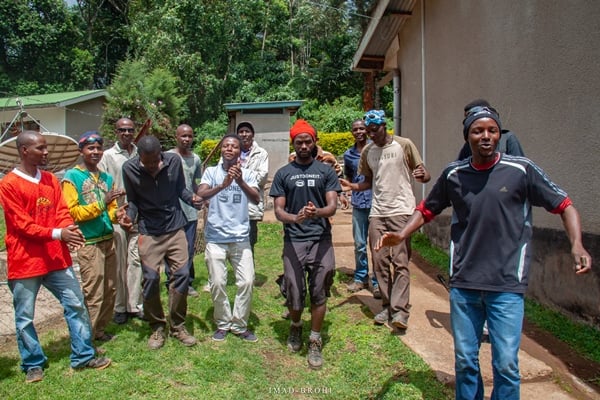 Day 7: Some spirited African song and dance to end the climb.
Day 7: Some spirited African song and dance to end the climb. Day 7: Return back to Arusha. It was a perfect day to be out. I just wanted to get back to the hotel for a warm shower after seven days.
Day 7: Return back to Arusha. It was a perfect day to be out. I just wanted to get back to the hotel for a warm shower after seven days.I recorded the trip on my GPS watch but lost the first two days of the tracks. A video of the trek from Shira Camp to Stella Camp is below:
All photos: Imad Brohi

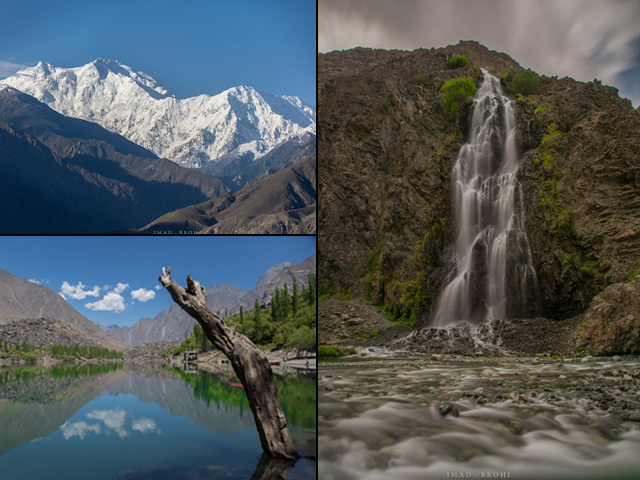
COMMENTS (2)
Comments are moderated and generally will be posted if they are on-topic and not abusive.
For more information, please see our Comments FAQ